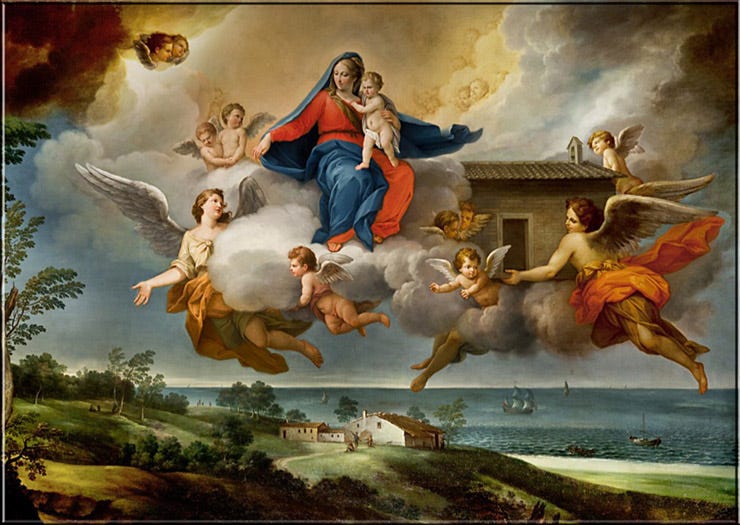Immaculate Conception
On Monday, the Catholic Church will celebrate the Solemnity of the Immaculate Conception of the Blessed Virgin Mary. Usually, it is celebrated on the 8th of December, but this year, the second Sunday of Advent takes precedence, so it has been moved to Monday, the 9th. We celebrate that our blessed mother was conceived without the stain of original sin, making her a fitting and worthy vessel for the Son of God to come into the world.
This dogma is relatively recent, about 170 years old. It was proclaimed infallibly by Pope Pius IX in 1854, which means that this doctrine is divinely revealed and must be accepted with faith by the entire Church. Four years later, Mary introduced herself to St. Bernadette as the Immaculate Conception in Lourdes, France. However, this belief was celebrated in some monasteries around the eighth century.
In the US specifically, bishops commended the nation to Mary's patronage under the title of the Immaculate Conception in 1846, and it became a nationwide holy day in 1885.
The Holy House of Loreto
I learned about the feast of the translation of the Holy House of Loreto when I was doing my consecration to St. Joseph earlier this year. According to historians, the home of the Holy Family remained in Nazareth for 13 centuries, but in May 1291, it mysteriously disappeared. The only thing left behind was the foundation.
According to tradition, angels transported the Holy House. Its first stop was Dalmatia, current-day Croatia, and it stayed there for three years. In 1924, Muslims invaded Nazareth and destroyed it. After a brief stay in Piceno and a quarrel between two brothers over who owned the house, it moved again to Loreto.
In 1296, the Catholic Church appointed 16 envoys to investigate everything. They measured the house in Loreto and compared it with the marks left on the ground in Croatia and again with the foundation left in Nazareth. They all matched. Chemical analysis of the house's stones and wood determined that the materials used were unique to Nazareth.
Tradition holds that this house is the site of the Incarnation and where the Holy Family lived. In the 16th century, a fortified basilica was completed around the Holy House to protect it from Muslim attacks. The Holy House was encased in Carrara marble to fortify the structure further. The feast of the translation of the Holy House of Loreto is celebrated on December 10th, and you can do a virtual tour of it here.
Our Lady of Guadalupe
Growing up in Mexico, devotion to Our Lady of Guadalupe was a given; it was part of the culture. It’s common for large groups of people to go on pilgrimages from the downtown area to the basilica; sometimes, employers even sponsor them. When I was in the Boy Scouts, I served a few of these pilgrimages by walking ahead and closing traffic so the pilgrims could advance. Recitation of the rosary and singing were part and parcel of the several hours-long ordeal.
A street market spanned several blocks and was full of vendors, and people gathered around the basilica. People are selling food, candy canes, candles, religious items, and blankets with tigers on them. Masses were happening every hour on the hour until almost midnight. Multiple matachines are dancing in the central plaza. There’s a festive atmosphere in the air for sure.
I tell you this because I would go on these pilgrimages but wouldn’t go into the sanctuary that much; I would stick around the market and hang out with my friends. In fact, for a long time, I saw devotion to Our Lady of Guadalupe as some borderline superstitious amulet Mexicans would use, as if Our Lady of Guadalupe was a vending machine that could get you anything you wanted from God.
This is obviously a gross generalization. I’m sure there are people with genuine devotion to Our Lady of Guadalupe who want to grow closer to Jesus by her intercession, but I grappled with these two sides of the devotion coin for a while. Then I met Diana and told her about my reservations regarding Marian devotions. She gifted me a book by Fulton J. Sheen called “The World’s First Love.” It was the first gift she gave and completely transformed my relationship with Our Blessed Mother.
I gained a better understanding of Mary's role in salvation history and how important she is in the life of any Christian. I am now a rosary prayer, scapular wearer, consecration crazy, immaculate heart tattooed man.
There will be several opportunities to honor Our Blessed Mother this next week. I encourage you not to waste any of them. In the words of St. Louis de Montfort, Mary is the safest, easiest, shortest, and most perfect way of approaching Jesus. I can’t recommend it enough.
Peregrino is a reader-supported publication. To receive new posts and support my work, consider becoming a free or paid subscriber.
Sobremesa
What’s your favorite Marian title?
Scapular or Miraculous Medal?
What’s your favorite mystery of the rosary?






Hello,
The original Virgin Of Guadalupe dates back from the 14th century Spain, being one of the Spanish Black Virgins from the Middle Ages. https://en.wikipedia.org/wiki/Our_Lady_of_Guadalupe_in_Extremadura
After the Spanish conquered México in 1520s and the Indian Juan Diego began seeing the Virgin in a place in the neighbouring of the newly founded city of Guadalupe, She was also named Guadalupe.
https://en.wikipedia.org/wiki/Our_Lady_of_Guadalupe#Origin_in_Guadalupe,_Spain
Just a bit of information.
1. Our Mother of Perpetual Help
2. Both
3. The Agony in the Garden